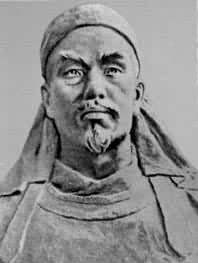The Tài Píng Rebellion
Southern China was the most affected region during the Opium War. Consumption was widespread and a great discontent reigned; the new infrastructure had left many porters unemployed, and there was animosity among the local population towards the Hakka people 客家人, an ethnic group from northern China recently established in the region.
It was precisely a Hakka called Hóng Xiùquán 洪秀全 who organized the revolt. Failed aspirant to official and converted to Christianity, Hóng had visions in which he discovered to be the little brother of Jesus Christ. The hatred and resentment towards the Qīng received divine mandates: God ordered the extermination of Manchu people. Hóng proclaimed the Heavenly Kingdom of Great Peace, Tài Píng Tiān Guó 太平天國, and headed north leading some 20,000 armed followers to take the city of Nanking 南京市, where a great massacre took place in which the Manchu population was exterminated.
In the north, General Zēng Guófān 曾國藩 organized an army of 120,000 peasant soldiers and, in a war that lasted ten years, recovered Nanking and crushed the rebellion. The official version says that the rebels were so fanatical that they committed suicide, although it is more likely that a systematic massacre took place.

Hóng Xiùquán, leader of the Tài Píng Rebellion
During the years in which the rebellion was still going on, other uprisings took place in the rest of China, and the imperial army took another four years to suffocate them. It is believed that the imperial army succeeded because the upper classes supported the dynasty.
Chan Heung's Eight Original Forms
At the time of the Tài Píng Rebellion, after founding the new style, Chan Heung created eight main forms. Joining the first word of the names of each of them was read Tai Ping Tin Gwok Choeng On Man Nin 太平天國长安万年 (in Mandarin, Tài Píng Tiān Guó Cháng Ān Wàn Nián), "Long Live the Heavenly Kingdom of Great Peace", a revolutionary slogan.
After the rebellion was crushed by imperial forces, the Qīng government began to hunt down any suspects who had participated in it. To avoid problems, the names of those eight main forms were changed.
It is believed that the original forms were:
Tai Zou Kuen 太祖拳, form of the Supreme Ancestor, whose name makes allusion to the first emperor of the Míng 大明 dynasty. This form changed the name to the one currently preserved: Mou Gik Kuen 无极拳. At present day very few schools know this form.
Ping Moon Kuen 平满拳, whose name literally means "pacifying the Manchu". The name of this form was shortened to Ping Kuen 平拳. As the Ping 平 character also means "flat", "leveled", this form is usually translated with the name "level fist".
Tin Dei Sap Fong Kuen 天地十方拳, "The Ten Directions of Heaven and Earth." This name was reduced to Tin Dei Kuen 天地拳, Form of Heaven and Earth. "Heaven and Earth" was the name of an anti-Qīng revolutionary society. Subsequently the name was changed to Sap Zi Kuen 十字拳, cross-pattern form (since the Chinese character for 'ten' 十 resembles a cross). When the form Siu Sap Zi Kuen 小十字拳 was added to the system, the name of this form was changed again to Dai Sap Zi Kuen 大十字拳.
Gwok Fa Kuen 国花拳, National Flower form. The peony had been the national flower for a long time, but the rebellion adopted the plum blossom as a revolutionary symbol, so this form was also known as Mui Fa Kuen 梅花拳 or Plum Blossom form. Again, when the Siu Mui Fa Kuen 小梅花拳 form was introduced into the system, the name of this original form changed to Dai Mui Fa Kuen 大梅花拳.
Choeng Gong Dai Long Kuen 长江大浪拳, Fist of the Great Waves of the Yangtze. As the name was very long, it shortened to Choeng Kuen 长拳 or "long fist".
On Bong Kuen 安邦拳, "Securing the Nation", which was then called Hung Yan Kuen 洪人拳, or Hung People form, referring to the Hung Moon 洪門 party, a revolutionary society. In order not to betray his support for the revolution, the practitioners of the style renamed it Hung Yan Kuen 雄人拳, this time using the Hung 雄 character which means 'powerful', 'masculine'. This is the form we normally know as Hung Yan Bat Gwa Kuen 雄人八卦拳, or Righteous and Strong Pa Kwa form.
Man Zoeng Kuen 万象拳, Fist of the Ten Thousand Forms, which today is called Dai Bat Gwa Kuen 大八卦拳 or Great Pa Kwa.
Nin Choeng Kuen 年长拳, Fist of the Elder, later renamed as Bak Mo Kuen 白毛拳 or White Hair form.
Sources:
- About the Eight Principal Forms: Wong Doc-Fai, Eight Principal Forms of Choy Li Fut, found at http://plumblossom.net/Grandmaster/eight-principal.html
